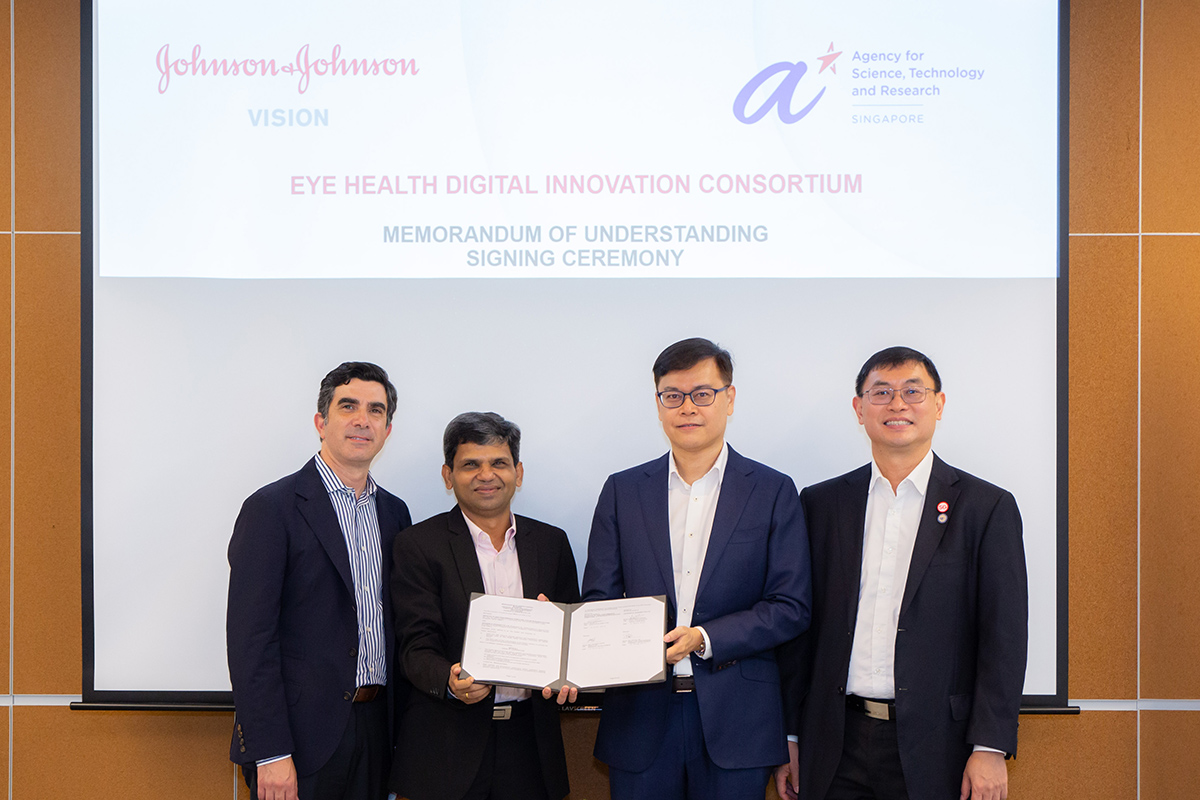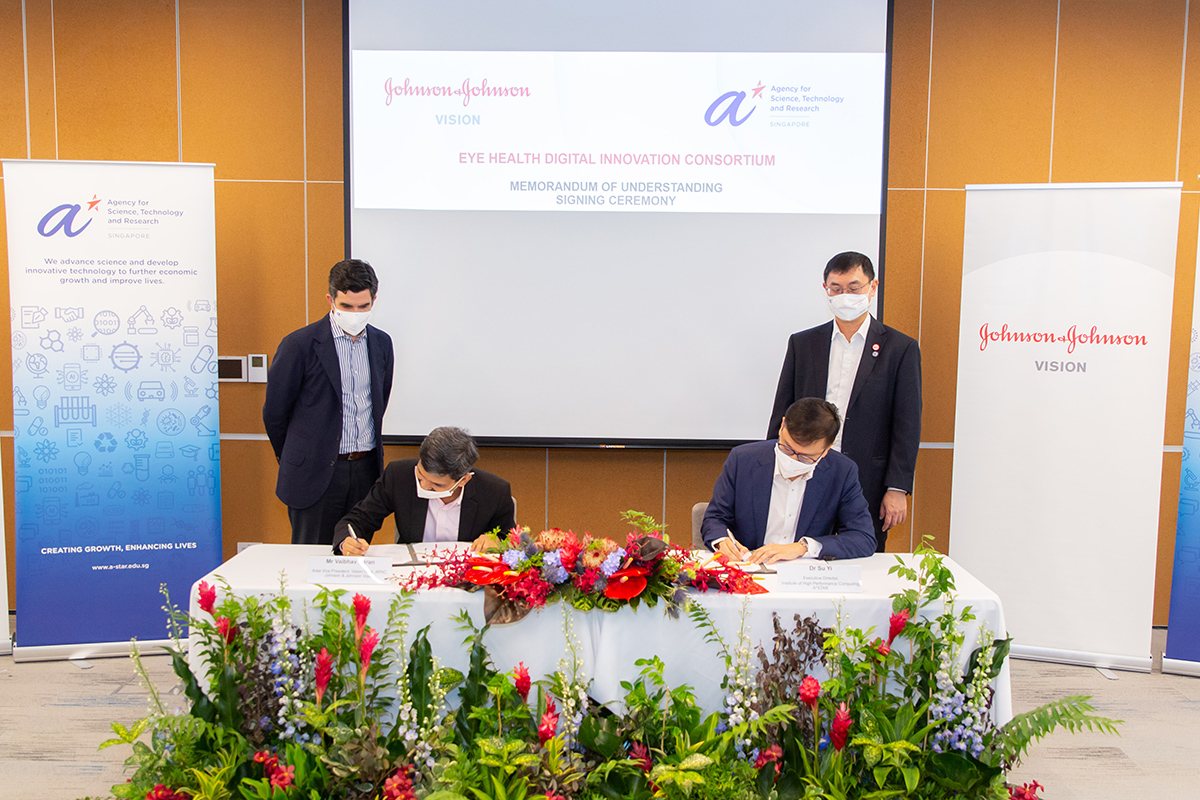THE VISION FOR BETTER EYE HEALTH IN APAC: JOHNSON & JOHNSON VISION AND A*STAR INK MOU FOR FIRST-OF-ITS-KIND EYE HEALTH DIGITAL INNOVATION CONSORTIUM
Combined expertise from both parties poised to make a significant impact and cement Singapore’s position as a Centre of Excellence in the Asia-Pacific region for eye health care, research and innovation.
Singapore, 12 July 2022 – Johnson & Johnson Vision*, a global leader in eye health and part of Johnson & Johnson MedTech**, has signed a Memorandum of Understanding (MoU) with the Agency for Science, Technology and Research (A*STAR) to jointly establish an Eye Health Digital Innovation Consortium. Hosted at A*STAR’s Institute of High Performance Computing (IHPC), the consortium focuses on advancing eye health research in the region.

(From left to right) Peter Menziuso, Company Group Chairman, Johnson & Johnson Vision, Vaibhav Saran, Area Vice President, APAC, Vision Care, Johnson & Johnson Vision, Dr Su Yi, Executive Director of A*STAR’s, Institute of High Performance Computing, and Professor Tan Sze Wee, Assistant Chief Executive of Enterprise, A*STAR, at the signing of the MoU, on Jul 12, 2022, marking the joint establishment of the Eye Health Digital Innovation Consortium.
A joint investment of SGD 15 million from both organisations will be channelled into the consortium over the course of three years.
As the first of its kind in APAC, the consortium will forge strategic public-private partnerships in the eye health space between eye care professionals (ECPs), academia, and the industry, to bring about innovations that will address pressing eye health needs. Through this consortium, stakeholders will be able to jointly identify and prioritise these needs, to accelerate research and innovation outcomes in the field.
The consortium aims to focus on the following areas the next three to five years, including but not limited to:
- improved eye health care delivery from ECPs to patients in Singapore and beyond;
- optimising collaboration between the private and public sector to enhance eye health care delivery; and
- developing new technological processes to support enterprises that are directly involved in primary eye health care delivery.
For a start, the consortium will see the creation of three new projects:
- MyoA*Bank: A digital data consent management platform that consolidates anonymised data for studies in eye health
- Behaviourally-informed messages to improve eye health behaviours, such as going for comprehensive eye health check-ups, a necessary standard of care which is not part of current norms
- E-referral and e-triaging for step-up and step-down care in the community
These initiatives leverage data-centric research and innovative technologies such as block chain, artificial intelligence (AI), data privacy preservation techniques, and personal data compliance, to create trusted data access and sharing relationships between patients, ECPs, researchers, clinical practitioners and public health policy makers.
These projects aim to deliver comprehensive solutions to change the trajectory of eye health in Singapore and beyond, and cement Singapore’s position as a Centre of Excellence in APAC for eye health care, research and innovation.
"Infusing our high science with greater access to eye health data is critical as we work to shape the standard of care, particularly for APAC’s continued battle with the rise of myopia.1 The wealth of knowledge that will be exchanged through this consortium will greatly enhance how we innovate bold solutions to improve healthy sight across APAC, and even more broadly," said Peter Menziuso, Company Group Chairman, Johnson & Johnson Vision.
“As a global leader in eye health, Johnson & Johnson Vision prioritises collaboration and working closely with stakeholders to deliver impact to the communities we operate in. This consortium has an exciting opportunity to drive digital solution platforms in the prevention and management of myopia and other eye diseases. These will help to enhance the eye health ecosystem that we are building,” said Vaibhav Saran, Area Vice President, APAC, Vision Care, Johnson & Johnson Vision.
"There is a high prevalence of eye disorders among Singapore’s population, and this is a cause for concern. Open innovation and public-private partnerships will pave the way for us to leverage strengths from different parties, and develop solutions to address this complex healthcare challenge. We look forward to a deeper partnership with Johnson & Johnson Vision, to co-create innovative eye care solutions for patients in Singapore and beyond," said Professor Tan Sze Wee, Assistant Chief Executive, Enterprise, A*STAR.
“IHPC is excited to partner Johnson & Johnson Vision in establishing the Eye Health Digital Innovation Consortium to advance eye health research in the region and improve general eye health care. IHPC will contribute expertise in blockchain and trust technologies to develop privacy-preserving data sharing solutions and computational behavioural modelling and AI to address public eye health concerns. We look forward to working closely with the ecosystem to create new value in translating eye health research technologies into digital solutions to benefit patients and open new business opportunities,” said Dr Su Yi, Executive Director, IHPC.
Annex A – Eye health needs in APAC
Annex B – Photos
About Johnson & Johnson Vision
At Johnson & Johnson Vision, part of Johnson & Johnson MedTech**, we have a bold ambition: to change the trajectory of eye health worldwide. Through our operating companies, we deliver innovation that enables eye care professionals to create better outcomes for patients throughout their lives, with products and technologies that address unmet needs including refractive error, cataracts, and dry eye. In communities with greatest need, we work in collaboration to expand access to quality eye care, and we are committed to helping people see better, connect better, live better. Visit us at jjvision.com, follow @JNJVision on Twitter, Johnson & Johnson Vision on LinkedIn, and @JNJVision on Facebook.
About Johnson & Johnson MedTech
At Johnson & Johnson MedTech, we unleash diverse healthcare expertise, purposeful technology, and a passion for people to transform the future of medical intervention and empower everyone to live their best life possible. For more than a century, we have driven breakthrough scientific innovation to address unmet needs and reimagine health. In surgery, orthopaedics, vision, and interventional solutions, we continue to help save lives and create a future where healthcare solutions are smarter, less invasive, and more personalised.
*Johnson & Johnson Vision represents the products and services of Johnson & Johnson Surgical Vision, Inc., Johnson & Johnson Vision Care, Inc., and the affiliates of both.
**Johnson & Johnson MedTech comprises the surgery, orthopaedics, vision and interventional solutions businesses within Johnson & Johnson’s MedTech segment.
1 Myopia prevalence among young adults is above 80% in many Asian regions. Reference: Ding, Bo-Yuan, et al. "Myopia among schoolchildren in East Asia and Singapore." Survey of ophthalmology 62.5 (2017): 677-697.
ANNEX A
EYE HEALTH NEEDS IN APAC
Neglecting eye health can lead to us losing the most precious of our senses: Sight. Sight is the most precious of our five senses, and accounts for 80% of what we learn and remember.2 Yet over one billion preventable cases of vision impairment globally are left unaddressed.3
Eye health issues affect those all over the world, and the Asia-Pacific region is no exception.
The Asia-Pacific region contributes disproportionately to the global burden of vision impairment and eye disease. Nearly two-thirds of patients with moderate-to-severe vision impairment come from East, South, and Central Asia, even though the population of these regions accounts for only 51% of the global population. The majority of these vision impairments come from conditions that could have been prevented or are yet to be addressed.4
One of the reasons for this trend is Asia-Pacific's rapidly ageing population. From 1990 to 2015, the absolute number of blind people increased by 17.6%, largely due to population growth and aging.5 South Asia has the highest age standardised prevalence of moderate to severe visual impairment at 17.5% and mild vision impairment at 12.2% globally.6 On the other hand, high-income countries of the Asia-Pacific region have the highest overall prevalence of myopia at 53.4%.7 In Singapore, the prevalence of myopia is among the highest in the world. It is predicted that by 2050, 80% to 90% of all Singaporean adults above 18 years old will be myopic and 15% to 25% of these individuals may have high myopia.8
Eye health needs in the Asia-Pacific region are complex and multifaceted, with major ocular diseases that impose a threat to vision differing across countries and subregions. For example, cataracts are the major blinding disease in developing countries, while glaucoma and diabetic retinopathy are priority diseases in high income countries.5
Additionally, although the Asia-Pacific region is highly populous and an enormous need for eye care exists for such a population, this currently remains an unmet demand. In Southeast Asia, only 4 out of 10 countries reached the target ophthalmologist-population ratio (1:100,000), and the urban-rural distribution is highly disproportionate with most ophthalmologists located in urban areas.9
Thus, as eye diseases and eye health needs become increasingly prevalent in the Asia-Pacific region, the development of innovative solutions and effective delivery of eye care is more critical than ever.
2 Journal of Behavioral Optometry. Children’s Vision Care in the 21st Century & Its Impact on Education, Literacy, Social Issues & the Workplace: A Call to Action. Accessed August 10, 2018.
3 World Health Organization (WHO). World Report on Vision. https://www.who.int/publications/i/item/9789241516570
4 A*STAR. Ophthalmology in Asia. https://www.a-star.edu.sg/docs/librariesprovider38/default-document-library/ophthalmology-in-asia.pdf
5 Rra B, Flaxman SR, Braithwaite T, et al. Magnitude, temporal trends, and projections of the global prevalence of blindness and distance and near vision impairment: a systematic review and meta-analysis. Lancet Glob Health 2017
6 Yusufu M, Bukhari J, Yu X, Lin TPH, Lam DSC, Wang N. Challenges in Eye Care in the Asia-Pacific Region. Asia Pac J Ophthalmol (Phila). 2021 Sep 8;10(5):423-429.
7 Holden BA, Fricke TR, Wilson DA, et al. Global prevalence of myopia and high myopia and temporal trends from 2000 through 2050. Ophthalmology 2016; 123:1036–1042
8 Ministry of Health Singapore. https://www.moh.gov.sg/news-highlights/details/speech-by-dr-lam-pin-min-senior-minister-of-state-for-health-at-the-opening-of-the-singapore-national-eye-centre-s-myopia-centre-16-august-2019
9 Das T, Ackland P, Correia M, et al. Is the 2015 eye care service delivery profile in Southeast Asia closer to universal eye health need. Int Ophthalmol 2018; 38:469–480.
ANNEX B

Shot 1: Group photo of signing
(From left to right) Peter Menziuso, Company Group Chairman, Johnson & Johnson Vision, Vaibhav Saran, Area Vice President, APAC, Vision Care, Johnson & Johnson Vision, Dr Su Yi, Executive Director of A*STAR’s, Institute of High Performance Computing, and Professor Tan Sze Wee, Assistant Chief Executive of Enterprise, A*STAR, at the signing of the MoU, on Jul 12, 2022, marking the joint establishment of the Eye Health Digital Innovation Consortium.

Shot 2: Proof of signing
Vaibhav Saran, Area Vice President, APAC, Vision Care, Johnson & Johnson Vision, and Dr Su Yi, Executive Director of A*STAR’s Institute of High Performance Computing sign MoU to establish the new Eye Health Digital Innovation Consortium. Peter Menziuso, Company Group Chairman, Johnson & Johnson Vision, and Professor Tan Sze Wee, Assistant Chief Executive of Enterprise, A*STAR, were also present to witness the signing.
